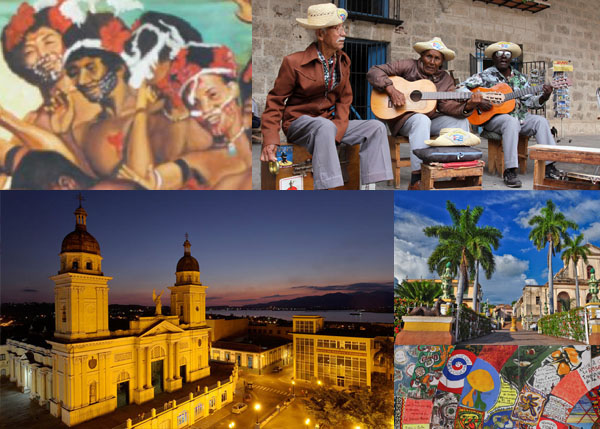10.7.6 The Aragon Orchestra.

The Aragón Orchestra was founded by a humble musician named Orestes Aragón Cantero, who was striving to form an orchestra. It was established in September 1939, in the province of Cienfuegos. Its first name was Rítmica 39; later, it was renamed Rítmica Aragón and finally Orquesta Aragón.
Prominent musicians from Cienfuegos were the founders of this group such as: pianist Rufino Roque, timpanist Orestes Varona, first violinist Filiberto Depestre, second violinist Hilario Candelario González, singer Pablo Romay and Noelio Morejón on the güiro.
Making their debut on the CMHJ radio station in Cienfuegos, the group performed the first Danzón, introducing listeners to the first songs of “Rítmica Aragón.” On that day, radio host Humberto Duarte changed the name of the group from Rítmica 39 to Rítmica Aragón, using the surname of Orestes, who was also the group’s administrator.
On October 9th, they played at their first dance, held at Ramón Rodríguez’s house. This was followed by performances at other dances, at the Black Society (based at the Minerva Club), and in towns such as Remedios, Camagüey, and Vertientes.
In 1940, Rafael Lay joined the orchestra at just thirteen years of age, replacing Hilario Candelario and René González. In 1941, Francisco Arboláez (Panchito) replaced Noelio Morejón on the güiro, and in 1945, Guido Sarría joined the orchestra as a tumbador player.
In 1948, a lung illness prevented the orchestra’s director and founder from continuing his duties, so Lay took over, opening a new era for the orchestra.
In 1950, the orchestra made its first trip to Havana. The help of Enrique Jorrín and the great Benny Moré was decisive in helping the Aragón Orchestra gain a foothold in Havana’s music market and conquer the capital. It quickly became the leading orchestra performing Cha-Cha-Chá and was appointed as the Cha-Cha-Chá stylists.
In May 1953, Loyola left the group to form his own band. He was replaced on flute by Rolando Lozano, and later by Richard Egües. José Antonio Olmo (Pepe) also joined the band, replacing Pablo Romay. That same year, La Aragón recorded the songs Tres lindas cubanas (Three Beautiful Cubans), Mentiras criollas (Crooked Men), Nunca (Never), and El agua de Clavelitos (The Water of Clavelitos).
In August 1955, contracts with Cristal Beer for the recording of a daily program on Radio Progreso and the recording of a record on RCA Victor paved the way for the definitive establishment of La Aragón in Havana.
Their first trip abroad was to Panama on February 8, 1956. In 1957, they performed at the Venezuelan carnival, and in 1958, they toured Guatemala and the United States.
In 1959, Rafael Bacallao (Felo) joined the orchestra as a singer. In 1963, Dagoberto González, violin, and Alejandro Tomás Valdés, cello, joined the band; later, Guillermo García replaced Guido Sarría on the conga drum.
La Aragón’s repertoire included diverse musical genres such as boleros, danzones, and foxtrot, and they even performed more modern styles, including rock and roll and 1960s pop.
In 1965, La Aragón was part of the Music Hall that toured several countries: the Soviet Union, Poland, the German Democratic Republic, and France; and participated in the Colombes, Calais, Chalon-sur-Saône, and Royal Festival Hall jazz festivals in England.
In 1980, Rafael Lay Bravo joined the group as a violinist. In 1982, Rafael Lay Apesteguía died in a tragic accident. The orchestra was conducted by the renowned flautist Richard Egües, until Rafael Lay Bravo took over in 1983.
Other Cuban musicians who have been members of the Aragón Orchestra include René Lorente, flute; Orlando Pérez, double bass; Julio Iznaga and Blas Egües, timpani; and Justo Emilio Rueda, singer.
The orchestra’s compositions featured works by important Cuban composers such as Ernesto Lecuona, Ñico Saquito, Juan Almeida, Ela O’Farrill, Arsenio Rodríguez, Portillo de la Luz, Virgilio González, Ñico Rojas, Rafael Lay, Richard Egües, and many others; these works have been compiled on more than one hundred LPs and CDs.
The Aragón Orchestra currently maintains a typical sound, standing out for its high level of interpretation, and its impeccable performance on instruments such as the flute, violins, timpani, güiro, piano, double bass, and congas.
Various stages around the world have applauded and enjoyed his music in countries such as Colombia, Puerto Rico, Mexico, Nicaragua, Chile, Dominican Republic, Jamaica, Guadeloupe Islands, Aruba, Martinique, Canada, United States, Japan, Greece, Italy, Hungary, Czechoslovakia, England, Finland, Egypt, Lebanon, Sierra Leone, Angola, Ivory Coast, Congo Brazzaville, Mali, Algeria, Tanzania, Benin, Guinea Bissau and Guinea Conakry.
The Aragón Orchestra has received numerous national and international awards, including the Distinction for National Culture, the Raúl Gómez García Medal, and the Félix Varela Order. It was nominated for a Latin Grammy for La Charanga eterna, the Best Traditional Tropical Album of 2002.








